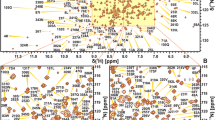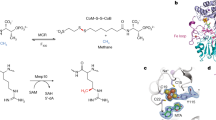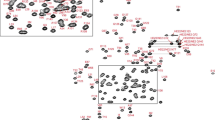Abstract
Enzymes produced by psychrophilic organisms have successfully overcome the low temperature challenge and evolved to maintain high catalytic rates in their permanently cold environments. As an initial step in our attempt to elucidate the cold-adaptation strategies used by these enzymes we report here the 1H, 15N and 13C assignments for the reduced form of a thiol-disulphide oxidoreductase from the Antarctic bacterium Pseudoalteromonas haloplanktis TAC125.


Similar content being viewed by others
References
Berjanskii MV, Wishart DS (2005) A simple method to predict protein flexibility using secondary chemical shifts. J Am Chem Soc 127:14970–14971
Collins T, Meuwis MA, Gerday C, Feller G (2003) Activity, stability and flexibility in glycosidases adapted to extreme thermal environments. J Mol Biol 328:419–428
Collins T, Roulling F, Florence P, Marx JC, Feller G, Gerday C, D’Amico S (2008) Fundamentals of cold-adapted enzymes. In: Margesin R, Schinner F, Marx JC, Gerday C (eds) Psychrophiles: from biodiversity to biotechnology. Springer, Berlin-Heidelberg, pp 211–228
Feller G, Gerday C (2003) Psychrophilic enzymes: hot topics in cold adaptation. Nat Rev Microbiol 1:200–208
Ginzinger SW, Gerick F, Coles M, Heun V (2007) CheckShift: automatic correction of inconsistent chemical shift referencing. J Biomol NMR 39:223–227
Horne J, d’Auvergne EJ, Coles M, Velkov T, Chin Y, Charman WN, Prankerd R, Gooley PR, Scanlon MJ (2007) Probing the flexibility of the DsbA oxidoreductase from Vibrio cholerae–a 15N–1H heteronuclear NMR relaxation analysis of oxidized and reduced forms of DsbA. J Mol Biol 371:703–716
Ito K, Inaba K (2008) The disulfide bond formation (Dsb) system. Curr Opin Struct Biol 18:450–458
Lamosa P, Turner DL, Ventura R, Maycock C, Santos H (2003) Protein stabilization by compatible solutes. Effect of diglycerol phosphate on the dynamics of Desulfovibrio gigas rubredoxin studied by NMR. Eur J Biochem 270:4606–4614
Medigue C, Krin E, Pascal G, Barbe V, Bernsel A, Bertin PN, Cheung F, Cruveiller S, D’Amico S, Duilio A, Fang G, Feller G, Ho C, Mangenot S, Marino G, Nilsson J, Parrilli E, Rocha EP, Rouy Z, Sekowska A, Tutino ML, Vallenet D, von Heijne G, Danchin A (2005) Coping with cold: the genome of the versatile marine Antarctica bacterium Pseudoalteromonas haloplanktis TAC125. Genome Res 15:1325–1335
Paxman JJ, Borg NA, Horne J, Thompson PE, Chin Y, Sharma P, Simpson JS, Wielens J, Piek S, Kahler CM, Sakellaris H, Pearce M, Bottomley SP, Rossjohn J, Scanlon MJ (2009) The structure of the bacterial oxidoreductase enzyme DsbA in complex with a peptide reveals a basis for substrate specificity in the catalytic cycle of DsbA enzymes. J Biol Chem 284:17835–17845
Schirra HJ, Renner C, Czisch M, Huber-Wunderlich M, Holak TA, Glockshuber R (1998) Structure of reduced DsbA from Escherichia coli in solution. Biochemistry 37:6263–6276
Williams ML, Chalmers DK, Martin JL, Scanlon MJ (2009) Backbone and side chain 1H, 15N and 13C assignments for the oxidised and reduced forms of the oxidoreductase protein DsbA from Staphylococcus aureus. Biomol NMR Assign. doi: 10.1007/s12104-009-9199-8
Wishart DS, Sykes BD (1994) The 13C chemical-shift index: a simple method for the identification of protein secondary structure using 13C chemical-shift data. J Biomol NMR 4:171–180
Acknowledgments
The NMR spectrometers are part of The National NMR Network (REDE/1517/RMN/2005), supported by “Programa Operacional Ciência e Inovação (POCTI) 2010” and Fundação para a Ciência e a Tecnologia (FCT). This work was funded by FCT, POCTI and FEDER; Projects POCI/BIA-PRO/57263/2004 and PTDC/BIO/70806/2006. TC is holder of a long term EMBO fellowship. MM is thankful to the Fundação para a Ciência e Tecnologia for its support through Programa Ciência 2007.
Author information
Authors and Affiliations
Corresponding author
Rights and permissions
About this article
Cite this article
Collins, T., Matzapetakis, M. & Santos, H. Backbone and side chain 1H, 15N and 13C assignments for a thiol-disulphide oxidoreductase from the Antarctic bacterium Pseudoalteromonas haloplanktis TAC125. Biomol NMR Assign 4, 151–154 (2010). https://doi.org/10.1007/s12104-010-9230-0
Received:
Accepted:
Published:
Issue Date:
DOI: https://doi.org/10.1007/s12104-010-9230-0




